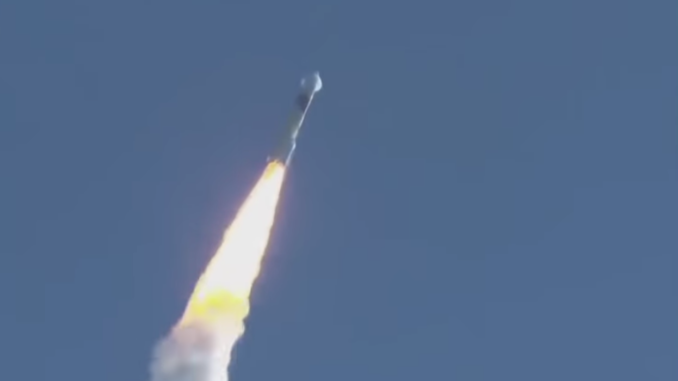
The United Arab Emirates (UAE) has joined a small group of countries who can call themselves space-faring nations. The tiny federation of emirates has previously sent three Earth-observing satellites into low Earth orbit, and an Emerati astronaut to the International Space Station. If all goes well, next year they’ll join an even smaller club – those that have successfully sent a spacecraft to Mars, which includes the US, the USSR/Russia, the EU/European Space Agency, and India. (China and Japan have not yet succeeded, though both have made attempts and China is about to try again).
The UAE spacecraft is called Hope (Arabic: Al’amal (الأمل)), a Mars orbiter which is the centerpiece of the Emirates Mars Mission, (also known as the Hope Mars Mission). Hope is on its way, having lifted off on Monday, July 20, at 6:58am JST (Japan Standard Time) [i.e., Sunday, July 19, 5:58pm EDT, 2158 UTC] from Tanegashima Space Center in southern Japan. The Mars orbiter was carried into space by a Mitsubishi Heavy Industries H-IIA, a rocket with an outstanding operational history.
The most efficient trajectory between Earth and Mars is only possible if launch from Earth occurs during a specific launch window, which only happens once every 26 months. The current window began July 14, and will close next month on August 15. Hope will take seven months to travel to Mars, arriving in February, 2021. The UAE gained independence from the United Kingdom on December 2, 1971. Hope’s arrival at Mars in February will help the Emirates celebrate the 50th anniversary of the country’s founding.
The United Arab Emirates Space Agency provided funding and oversight for the spacecraft and mission. Design and construction of Hope was performed by the Mohammed Bin Rashid Space Centre in partnership with the University of Colorado Boulder, Arizona State University, and the University of California, Berkeley. The three universities have expertise building spacecraft for other agencies, including NASA.
Hope carries three separate instruments: an imager (read sophisticated high-resolution digital color camera), an UV (ultraviolet) spectrometer, and an IR (infrared) spectrometer. The primary objective is to study Mars’ weather and atmosphere, the first mission dedicated to such Martian research. Scientist also hope to find the cause of Mars’ climate change and the reasons why the planet’s oxygen and hydrogen are escaping into space. The mission is designed to last a minimum of one entire Martian year (two Earth years) so that all of Mars’ seasons can be observed and studied.
The Hope Mars Mission is part of the government’s plan to move away from an economy dependent on oil towards an information and knowledge-based economy. To that end, the goals of the project include providing a boost to the country’s science and technology economic sectors, and to inspire Arab youth to pursue an STEM (Science, Technology, Engineering, Mathematics) education. Centuries ago, Arabs were world leaders in the fields of astronomy, science, and mathematics. The Emirates want to return to that lofty stature, thus the reason why the name ‘Hope’ was chosen out of many suggestions submitted.
Mohammed Bin Rashid Space Centre is also building a “Mars City” in the desert to emulate a Mars colony, a sort of living laboratory. This is in support of the UAE’s ambitious plan to build a permanent colony on Mars by the year 2117.
It sends a very strong message to the Arab youth that if the UAE is able to reach Mars in less than 50 years, they could do much more.
Omran Sharaf, Project Director, Emirates Mars Mission
Two more missions to Mars are planned to launch within the next ten days. China’s Tianwen-1 is currently scheduled for launch on July 23, and NASA’s Perserverance (and Mars Helicopter) is currently scheduled for liftoff on July 30.
Question of the Night: If the stars aligned such that it was not only possible but easy for you to go back to school, what subject would you most like to study?
